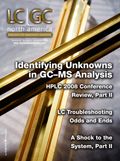Agilent and University of Technology Sydney Establish Elemental Bioimaging Facility
Agilent Technologies (Santa Clara, California) and the University of Technology Sydney (UTS, Sydney, Australia) have established the UTS Elemental Bio-Imaging Facility to study trace metals and other elements in tissue and their effects on health.
Agilent Technologies (Santa Clara, California) and the University of Technology Sydney (UTS, Sydney, Australia) have established the UTS Elemental Bio-Imaging Facility to study trace metals and other elements in tissue and their effects on health. The facility opened on June 27. Agilent is providing an ICP–MS system, an LC–MS system, funding for project work, scholarships for graduate students for research in bioimaging, technical consulting, and a grant to develop imaging technology.

How Many Repetitions Do I Need? Caught Between Sound Statistics and Chromatographic Practice
April 7th 2025In chromatographic analysis, the number of repeated measurements is often limited due to time, cost, and sample availability constraints. It is therefore not uncommon for chromatographers to do a single measurement.
What Goes in a CDS IT Service Level Agreement?
April 7th 2025Protecting your network chromatography data system (CDS) data is critical and a service level agreement (SLA) with your IT provider is vital. What should be included? Are SLAs for in-house IT and SaaS (software as a service) similar?












